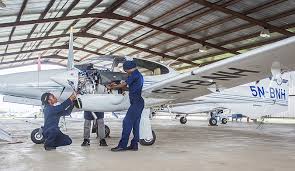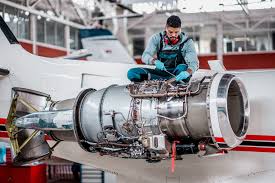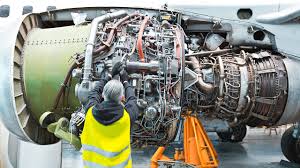- Udoh, Ogbebor raise concerns over aviation manpower shortage
- Air Peace's operations disrupted as lessor withdraws airplanes, passengers stranded nationwide
- German firm, Aero-Sys appoints Belujane Konzult as rep in Nigeria
- Nigeria ready to offer South Africa Fifth Freedom traffic right
- How passenger unruly behaviour undermines safety gains in aviation sector-FAAN MD
Seeking solution to dearth of skilled manpower, ageing workforce

Manpower development could be ensured via scholarships and sponsorships from organisations and well-meaning individuals, especially to young aviators as this is fundamental to the sustainable development of the sector, writes WOLE SHADARE
Survey outcome
Fourty-five per cent of industry leaders in a recent survey identified a labour shortage in the maintenance technician field as the most urgent challenge in aerospace and aviation.
Global demand for aviation skills is set to overtake supply by 2027 with airlines and international MRO providers identifying one clear reason: a lack of interest in aviation from younger talent pools.

The age of MRO technicians in the industry has climbed to above-average levels, creating space for younger aviation technicians to enter the workforce; however, this gap is not being filled.
The stringent educational prerequisites and complex certification processes present significant barriers for individuals aspiring to enter the aviation maintenance field. While safety standards mandate comprehensive training, extensive academic qualifications and rigorous certification procedures can dissuade potential candidates.
Falling popularity
Aviation in Nigeria and some other places is falling in popularity with school students, meaning young people are choosing office jobs instead of becoming engineers. The astronomical fund for training young people in engineering and other fields of aviation is gradually pushing them away from having an interest in the sector.
Suppose numbers of aviation technicians continue to fall. In that case, the sector will face challenges of unprecedented proportions just like it is presently facing in the country as experienced engineers, who started their careers with the defunct Nigeria Airways, have become old. Some have died as a result of old age and other related ailment.
Nigeria Airways was the production mill for pilots, engineers, cabin crew and other technical hands that at its peak was capable of exporting thorough-bed professionals to other countries.
Since the airline’s demise in 2003 by former President Olusegun Obasanjo in a very destructive manner, it has brought a serious setback to the entire aviation industry coupled with its domino effect on other sectors related to aviation.
Expert’s view
An aircraft engineer, who spoke to our correspondent under anonymity, said: “Imagine a world without airplanes. Businesses would be reliant on costly and time-consuming transportation methods, resulting in a slower and less productive economy. Individuals and families would enjoy far fewer holidays, with many people never having the chance to experience other cultures or create precious memories with loved ones.”
“Airlines and aircraft manufacturers not only build planes, they serve as catalysts for new life experiences and are an integral part of our modern lives. The solution to the aviation skills shortage lies in positioning the aerospace and aviation sector as an interesting and rewarding career choice that can give engineers and technicians a career like no other industry.
“In a globally connected world where students are bombarded with choices, we need to shout louder to reach potential aviation engineers and technicians or we risk losing out on talent. Young people in schools are unaware of the breadth of amazing aviation careers all over the world – we need to show them what they’re missing.”
Boeing’s outlook
Aircraft giant, Boeing, had raised concern over the dearth of pilots, technicians, and cabin brew as the plane maker In its 2022-2041 Pilot and Technician Outlook (PTO), Africa is set to need 20,000 pilots, 21,000 technicians, and 26,000 cabin crew.

In Nigeria, the scarcity of skilled manpower to replace the ageing workforce is putting the country’s aviation industry on the edge as the Nigerian College of Aviation Technology (NCAT), Zaria trains professionals yearly without companies to engage them for their services.
There is also a shortage of pilots in the country as indigenous pilots roam the streets while many others have ventured into other businesses not related to the profession they spent several millions of dollars to acquire their licenses and other certifications.
Aside from Nigeria, the global aviation industry is facing a similar problem. A widespread deficit of pilots across all continents has affected the sector, particularly in recent years, with cases of pilot shortages regularly occurring.
Nigeria’s case is ironic because while so many young pilots and aircraft engineers are seeking to fly for airlines, airline operators are looking for very experienced pilots and engineers who are not being replaced.
The shrinking size of aircraft in the fleet of airline operators has forced many Nigerian pilots to seek greener pastures outside the shores of Nigeria.
The shortage of aircraft engineers for many operators of Maintenance Repair Overhaul (MRO) in Nigeria has led to a capacity deficit and as such has led to the commensurate expansion of many of the nation’s MRO operators.
Boeing in its projection made available to Aviation Metric estimated that 602,000 pilots, 610,000 maintenance technicians, and 899,000 cabin crew members will be required to operate the global commercial fleet set to nearly double to 47,080 aircraft by 2041.
The aerospace and defence giant, projected increased demand for 2.1 million new aviation personnel over the next 20 years to support the commercial aviation sector’s steady recovery and meet the anticipated surge in demand for air travel over the forecasted period.
Boeing estimated that 602,000 pilots, 610,000 maintenance technicians, and 899,000 cabin crew members will be required to operate the global commercial fleet set to nearly double to 47,080 aircraft by 2041.
The 2022 projections surpass 2021 estimates by 3.4%, excluding the Russian Federation in line with the Western sanctions forbidding aircraft exports to the transcontinental country.

China, Europe, and North America collectively represent more than 50% of the total global demand for aviation professionals, with Africa, Southeast Asia, and South Asia taking the lead as the fastest-growing markets expected to grow by 4% over the projected period.
“As the commercial aviation industry recovers from the pandemic and plans for long-term growth, we anticipate a steady and increasing demand for aviation personnel, as well as the ongoing need for highly effective training,” Boeing Global Services’ Vice President of Commercial Training Solutions, Chris Broom said, stressing that the company’s customer-centric approach and digital expertise include a commitment to delivering data-driven, competency-based training and assessment solutions as well as technologies that meet customers’ evolving needs.
According to the PTO, Africa is set to need 20,000 pilots, 21,000 technicians, and 26,000 cabin crew. Meanwhile, China will require 126,000 pilots, 124,000 technicians, and 162,000 cabin crew.
The European market demand for pilots is estimated to reach 122,000, 120,000 technicians, and 207,000 cabin crew, while the Latin American market will need 35,000 pilots, 35,000 technicians, and 48,000 cabin crew.
For the Middle East, 53,000 pilots, 50,000 technicians, and 99,000 cabin crew will be needed compared to 128,000; 134,000, and 173,000 respectively in North America and 22,000, 24,000 and 38,000 in Northeast Asia.
Furthermore, Oceania will require 9,000 pilots, 10,000 technicians, and 18,000 crew members, compared to 37,000, 34,000, and 43,000 in South Asia and 50,000 pilots, 58,000 technicians, and 85,000 crew in Southeast Asia.
Serious challenge
Aviation expert and a member of the Agency for the Air Navigation Safety in Africa and Madagascar (ASECNA) Kamata Joel, has said that having the appropriate number of skilled workers in the aviation industry in Africa still poses a serious challenge.
He reiterated that sectors like meteorological assistance to aviation, firefighting, ground support services and airport commercial fields must not be neglected though relatively less impacted.
The training sector, which is sometimes neglected, he noted, was not an exception, stressing that the continent needs considerable manpower in the short term as well as the medium and long term.
Last line

While the demand for technical skills is persistent in aircraft maintenance, flight operations, air traffic control, airport maintenance, and management, achieving the goal of sufficient, skilled, and efficiently trained manpower would require a sustained synergy and partnership among critical stakeholders.
Google+

